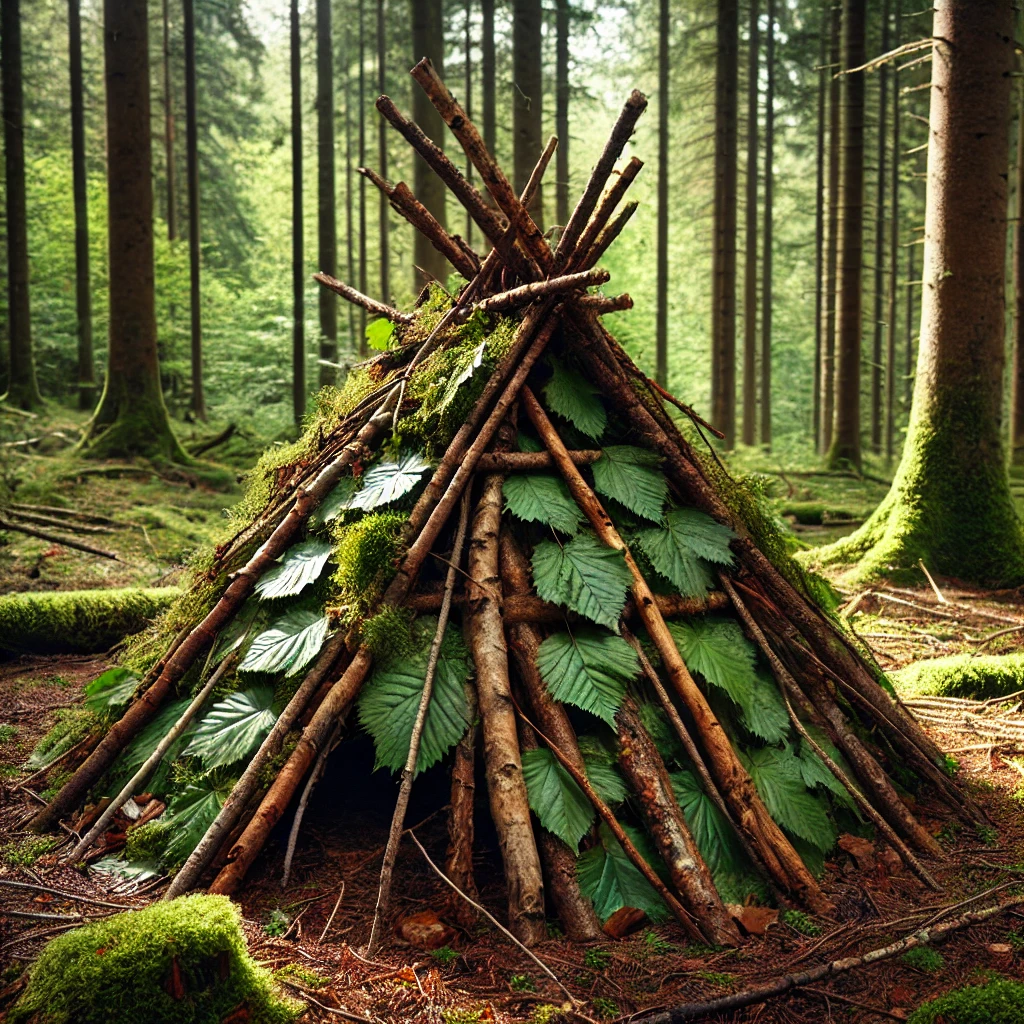Shelter Building Techniques for Different Environments
Introduction:
When venturing into the wilderness or surviving in extreme conditions, the ability to build an effective shelter is crucial for protection, warmth, and safety. Different environments require distinct shelter-building techniques due to their varied climates, terrain, and available resources. This article will delve into shelter-building techniques suitable for different environments, including forests, deserts, mountains, snowy areas, and tropical regions.
1. Forest Shelters
Forests offer an abundance of natural resources that can be used to build shelters. The dense foliage provides excellent cover, but it’s important to choose your location carefully, avoiding areas prone to flooding or falling branches.
a. Debris Hut
- Materials: Branches, leaves, moss, and bark.
- Construction:
- Start by creating a framework using a sturdy central ridgepole, propped up by two forked sticks.
- Lean branches against the ridgepole to form the walls, creating a triangular shape.
- Cover the framework with leaves, moss, or bark for insulation. The thicker the covering, the better the insulation.
- Place additional debris on the ground to create bedding.
- Advantages: Provides warmth, insulation, and camouflage. Ideal for cold and temperate forest areas.
b. Lean-To Shelter
- Materials: Long branches, foliage, and cordage (if available).
- Construction:
- Prop one large branch between two trees or supports.
- Lean smaller branches at an angle against the main branch to form a sloping wall.
- Cover the sloped wall with leaves, twigs, and foliage for protection against wind and rain.
- Advantages: Quick and easy to build, offers wind protection. Suitable for mild to moderate weather.
c. A-Frame Shelter
- Materials: Branches, leaves, foliage.
- Construction:
- Create two vertical structures at each end using forked sticks and a horizontal branch between them.
- Lean branches at a 45-degree angle on both sides of the horizontal branch, forming an A-shape.
- Cover the entire structure with foliage for insulation.
- Advantages: Sturdy and offers more headroom compared to a lean-to. Excellent in moderate climates.

You May Also Like: Understanding Natural Disasters: How to Prepare for Earthquakes, Hurricanes, and More
2. Desert Shelters
Deserts are challenging due to extreme heat during the day and cold temperatures at night. The key to building a shelter in the desert is to protect yourself from the sun and preserve body moisture.
a. Natural Shade Shelter
- Materials: Nearby rocks, cliffs, or sparse vegetation.
- Construction:
- Locate natural features such as large rocks, cliffs, or trees that provide shade.
- Use these features to your advantage, positioning yourself on the shaded side.
- If no natural shade is available, use a blanket or tarp to create an artificial canopy by tying it between rocks or branches.
- Advantages: Provides relief from the sun, easy to construct.
b. Dig Pit Shelter
- Materials: Sand, foliage, or tarp.
- Construction:
- Dig a shallow pit in the sand, about 1–2 feet deep.
- Line the bottom with any available vegetation for insulation.
- Use a tarp or clothing to cover the pit, anchoring it with rocks to create shade.
- Advantages: Offers protection from the sun and reduces exposure to wind. Suitable for hot daytime temperatures.
c. Wadi Shelter
- Materials: Rocks, sand, and any available fabric.
- Construction:
- Choose a dry riverbed (wadi) and construct a simple shelter by piling rocks on top of each other to create walls.
- Use branches or fabric to form a roof over the rock walls.
- Ensure the wadi is dry, as flash floods can occur unexpectedly.
- Advantages: Provides wind protection and insulation from the heat.
3. Mountain Shelters
Mountain environments can be unpredictable, with sudden temperature drops and strong winds. Shelters here need to be sturdy and provide insulation from the elements.
a. Rock Shelter
- Materials: Rocks, boulders, and vegetation.
- Construction:
- Find a naturally occurring rock overhang or cave that provides protection from the wind and rain.
- If necessary, use rocks to build a low wall at the entrance to block wind.
- Line the floor with grass or leaves for insulation.
- Advantages: Provides natural protection and insulation. Ideal for windy and rocky terrains.
b. Tarp Shelter
- Materials: Tarp, rope, rocks, or trees.
- Construction:
- Use rope or branches to secure a tarp between trees or rocks, creating a windproof structure.
- Ensure the tarp is angled to deflect wind and rain.
- Advantages: Easy to set up and lightweight. Ideal for backpackers or hikers in moderate to extreme weather conditions.
4. Snow and Ice Shelters
In snowy or arctic environments, insulation from the cold is essential. Snow can act as an excellent insulator when used correctly.
a. Snow Cave
- Materials: Snow, shovel, or improvised digging tools.
- Construction:
- Find a deep snowbank or drift.
- Dig a tunnel into the snow and hollow out a cave-like structure large enough to fit your body.
- Create a small ventilation hole at the top to prevent suffocation.
- Line the floor with leaves, branches, or insulation materials.
- Advantages: Provides excellent insulation and protection from wind. Suitable for deep snow conditions.
b. Quinzhee
- Materials: Snow, shovel, and foliage.
- Construction:
- Pile snow into a large mound and let it settle for an hour.
- Hollow out the inside of the mound, leaving walls at least 12 inches thick for insulation.
- Create a small entrance and a ventilation hole.
- Advantages: Easier to construct than an igloo, offers excellent insulation in snowy environments.
c. Igloo
- Materials: Blocks of compact snow.
- Construction:
- Cut compacted snow into blocks using a saw or a knife.
- Arrange the blocks in a circular pattern, gradually leaning them inward to form a dome.
- Create a small entrance tunnel to minimize heat loss.
- Advantages: Stable and warm, ideal for Arctic or snowy regions.
5. Tropical Rainforest Shelters
Tropical rainforests are hot, humid, and prone to heavy rainfall. Shelters here must prioritize ventilation and protection from rain.
a. Platform Shelter
- Materials: Bamboo, large leaves, and vines.
- Construction:
- Build a raised platform using bamboo or strong branches to avoid ground insects and water.
- Construct a roof using large leaves or palm fronds to protect against rain.
- Secure the roof using vines or other natural materials.
- Advantages: Elevates you off the wet ground, provides rain protection and ventilation. Ideal for humid climates.
b. Tarp Hammock Shelter
- Materials: Tarp, hammock, rope.
- Construction:
- Secure a hammock between two trees.
- Drape a tarp over the hammock to create a roof that shields you from rain.
- Ensure the tarp covers the sides and is securely tied down to prevent water from seeping through.
- Advantages: Keeps you off the ground, excellent for rain protection, easy to set up.
Conclusion
Shelter building is an essential survival skill, and the techniques vary depending on the environment you find yourself in. Understanding the resources available and the specific challenges each environment presents is key to building an effective shelter. From forests to deserts, mountains, snowfields, and tropical rainforests, knowing how to adapt your shelter to the terrain and weather conditions will keep you safe and protected in the wilderness.
Also Visit: The Fundamentals of Insurance: Why It’s Crucial




1 comment